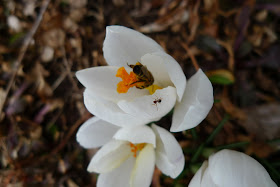Wren and I have just returned from a magnificent trip to Barcelona and environs. Along the way, I took photos of all things bee-related, as shown below.
First of all, we were excited to find that the taxis in Barcelona resemble bees. Here they are "swarming" in front of the train station.

In the Priorat region, we found some honeybees working these flowers—the only flowers we saw blooming in the mountaintop village we were visiting in this beautiful wine-making region. However, nearby, the almond trees were in abundant bloom, so the bees had plenty of forage available.

I was beside myself with happiness to find this Hello Kitty bee at the grocery store and brought her along on our travels.

We named her Chavela Abeja.

Here's Wren showing off another bee toy during a visit me made to
a beekeeper in the Priorat. I'll do a separate post about that visit soon.

A window display.

Bee-related merch.

A chocolate honeybee.

Chocolate honeybee lollipops—three of the nicest words in the English language!

A package of honey that came with breakfast in our hotel during our three-day visit to the Costa Brava.

Another window display.

A candle shop window in Barcelona.

Jars of honey in a shop window.

Bonus shot: mosquito graffiti!




 A recent issue of American Bee Journal made mention of the availability of two newly reprinted beekeeping books by Applewood Books, publisher of a nifty variety nature books, farming guides, "floral and gardening" books, and many other topics in keeping with its mission to "build a picture of America through its primary-source materials." The charmingly titled volume pictured above is one of Applewood Books' many reprints of interest.
A recent issue of American Bee Journal made mention of the availability of two newly reprinted beekeeping books by Applewood Books, publisher of a nifty variety nature books, farming guides, "floral and gardening" books, and many other topics in keeping with its mission to "build a picture of America through its primary-source materials." The charmingly titled volume pictured above is one of Applewood Books' many reprints of interest.


 Here are a couple of other out-of-copyright beekeeping and bee-related books you can find on Google Books:
Here are a couple of other out-of-copyright beekeeping and bee-related books you can find on Google Books:
 But it gets even better: "A White House carpenter who is a beekeeper will tend two hives for honey,"quoth the New York Times.
But it gets even better: "A White House carpenter who is a beekeeper will tend two hives for honey,"quoth the New York Times. To read about one of the groups that advocated tirelessly for this exceedingly good idea, visit eattheview.org.
To read about one of the groups that advocated tirelessly for this exceedingly good idea, visit eattheview.org. Of course, this doesn't mean we're forgetting about the birds.
Of course, this doesn't mean we're forgetting about the birds.
 This is the stuff that makes life worth living, no?
This is the stuff that makes life worth living, no? As if the wallpaper weren't Thrill Factory enough, get a load of these honeybee lace curtains—also from Candace Wheeler.
As if the wallpaper weren't Thrill Factory enough, get a load of these honeybee lace curtains—also from Candace Wheeler.
John Muir







 Chocolate honeybee lollipops—three of the nicest words in the English language!
Chocolate honeybee lollipops—three of the nicest words in the English language!




